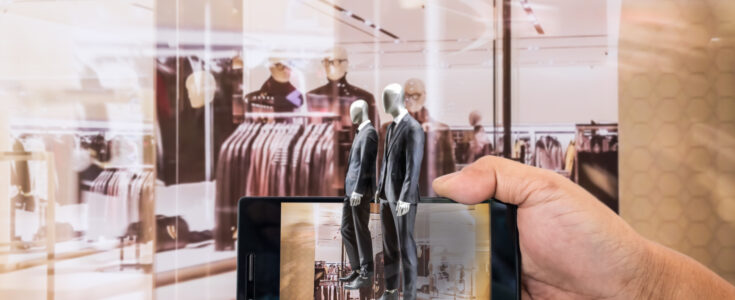
Top 6 Reasons Why Omnichannel Experience Strategy Is Important For Boosting eCommerce Sales

Omnichannel retail is a multichannel approach to earning sales that aim to offer the customer a seamless shopping experience whether the customer is buying online from a mobile device, a laptop computer, or in a brick-and-mortar shop.
The omnichannel experience features real integration of channels on the back end, providing a seamless experience across all the touchpoints.
What is the difference between Omnichannel & Multichannel?
Multichannel
Multichannel is an approach where a business is present on multiple channels, which its shoppers can utilize to interact with the brand. These channels can be mobile apps, mobile websites, emails, brick-and-mortar stores, social media channels, etc. Shoppers expect to have a seamless experience with a brand, instead of having a fragmented experience on each channel. At this point, omnichannel comes into play.
Omnichannel
An omnichannel eCommerce strategy foresees that customers may start exploring on one channel and move to another as a progress of their online purchasing journey. Omnichannel completes a multichannel process and optimizes it for present age customers.
For instance, when a business has obtained the omnichannel approach, its customer care representative can directly cite its previous preferences and purchases as quickly as the customer service online chat representative or the customer care representative phone can.
The buyer can also use the laptop computer to check the store inventory on its website, buy the products later using a tablet or smartphone, and pick up the product at the buyer’s preferred location.
Businesses like Lightspeed and Netsuite have made considerable investments in providing omnichannel software solutions for retailers. For years retailers have sustained their businesses using various platforms for their POS, eCommerce website, ordering systems and accounting. So why do retailers hear the omnichannel buzzword so often? – and how does it matter?
Let us look at the top 6 reasons why Omnichannel implementation is must-have in the present age.
Also read: 5 ECommerce Marketing Trends That Cannot Be Avoided In 2021
1. 50% of shoppers expect to buy online and pick-up at the store – (BOPIS)
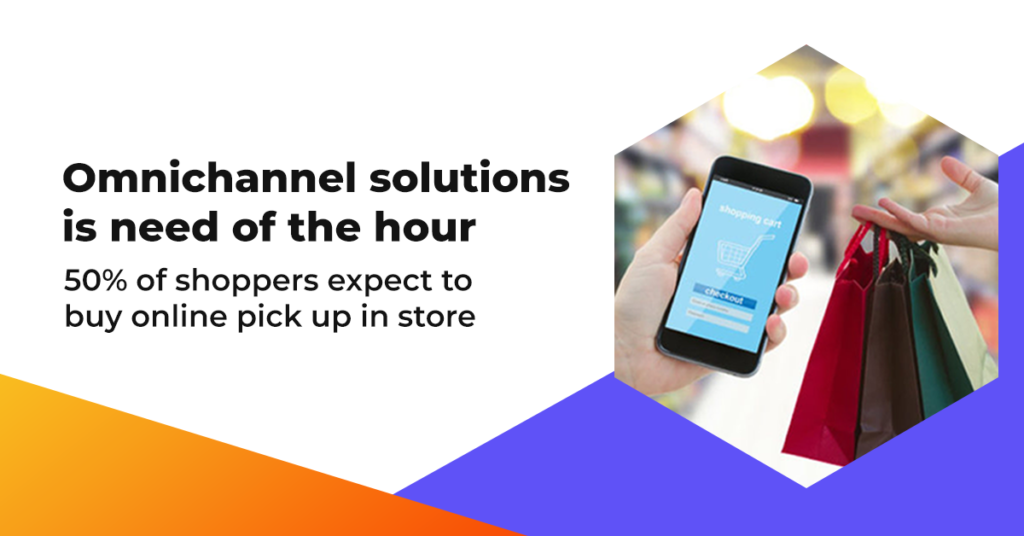
Retailers presently are adopting the BOPIS model to meet consumers expectations. Buy online, pick up in-store is an excellent way for retailers to drive in-store footfall and combine their offline and online experiences.
In a recent Fisher study, 90% of online consumers survey declared high shipping fees and home delivery that takes more than two days would stop them from making a purchase online. Thanks to businesses like Amazon, present shoppers are usually receiving their products at a much quicker rate, requiring more options that fill the void between online, offline, and everything.
Businesses recognize the importance of enabling BOPIS to exclude shipping and processing pains while delivering a convenient shopping experience. According to a recent survey, 61% of retailers say that BOPIS tops the list of their omnichannel strategies and investments.
As businesses are increasingly implementing BOPIS into their omnichannel retail strategy, retailers need to understand that to witness increasing sales on both retail and online platforms; it is essential to invest in BOPIS.
Also read: Omni-Channel Challenges : Beyond Multi-Channel
2. Shoppers purchasing from a business both in-store and online have a 30% higher lifetime value than those who buy using only one channel.
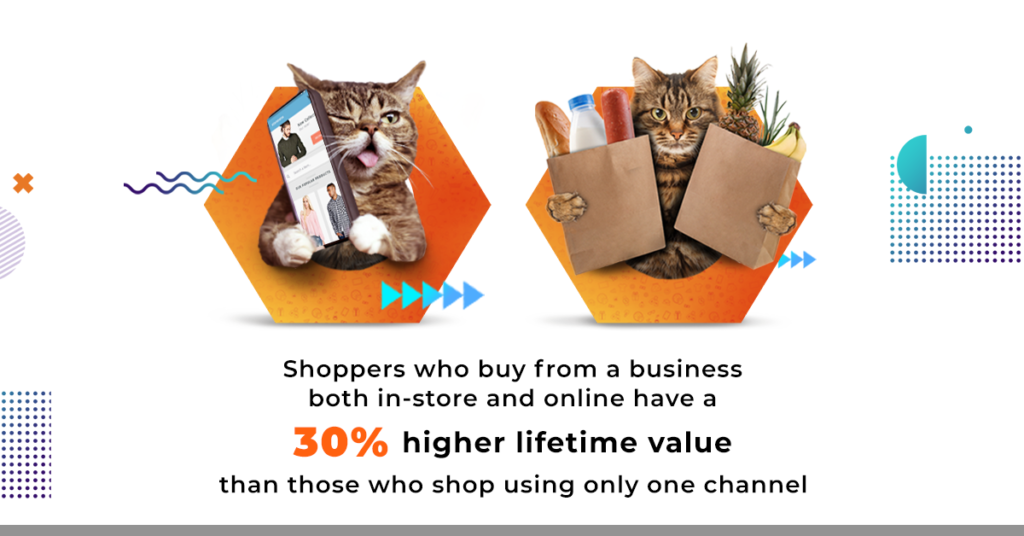
The retail marketing is changing. In the current scenario, success means grasping buyers wherever they are, on any device they may be using. Frequently, that means smartphones. According to Google data, mobile shopping clicks exceeded those on the desktop as shoppers made their purchase decisions on the go during the holiday season.
Shoppers are no longer distinguishing between mobile and desktop when it comes to purchasing, whether in a store or on an eCommerce website. This trend creates new realities for retailers, as we’ve seen from our recent research with Ipsos MediaCT and Sterling Brands. Chief among them is that digital mediums don’t just drive eCommerce; they get footfall in the shop. And this influence doesn’t end at the shop entrance:
71% of buyers who use smartphones for research in-store say that it’s become an essential part of their experience. Smartphones are the modern personal shopping assistant for people once they’re inside.
As digital platforms continue to touch every step of the customer journey, multichannel retailers who operate both eCommerce and in-store channels have to take note. They’re changing how they think about omnichannel shoppers and what their shopping behaviour means for the overall business. The most sophisticated retailers ensure that their selling strategies enable shoppers to convert on any channel. Why? Because they understand that a customer who buys from them in-store and online is their most important customers. These customers have a 30% higher lifetime value than those who shop using only one channel, says a 2015 study by IDC.
Also read: Google Analytics 4 (GA4) – A Complete Guide With Introduction And Highlights
3. Omnichannel strategies drive an 80% higher rate of incremental store visits.

Even though so much commerce takes place online, brick and mortar stores are still around and are far from becoming extinct. Mobile searches for “near me” has grown more than 300% over the last two years. Also, approximately 80% of consumers will go to the store when they need something immediately.
Lastly, mobile searches have increased over the past two years for “where to shop” and “where to buy” have increased by 85%.
This is good news for retailers, as they have a grand opportunity to use these physical retail locations to fulfil today’s impatient shoppers’ expectations. This can only be achieved by retailers always being on-target with their support, making sure that these high-intent customers find just what they need when they require it while they are in the area of the shop and ready to shop.
For local retailers to maximize their customers’ purchasing behaviours, they must thoroughly combine their local and digital strategies. Omnichannel strategies (strategies that determine what’s in stock at nearby shops and increasing bids around your business locations) drive an 80% rise in incremental store visits. Within one mile of a store, the click-through rate hikes by 28% and the store-visit rate rises by 57%. When customers within five miles of a shop clicked on a search ad, their store visit was likely to be increased 1.7 times than those beyond five miles.
Also read: The Future Ready Enterprise ECommerce Business
4. 61% of customers are confused to switch from one channel to other due to broken omnichannel integration, leaving shoppers with a puzzled customer experience
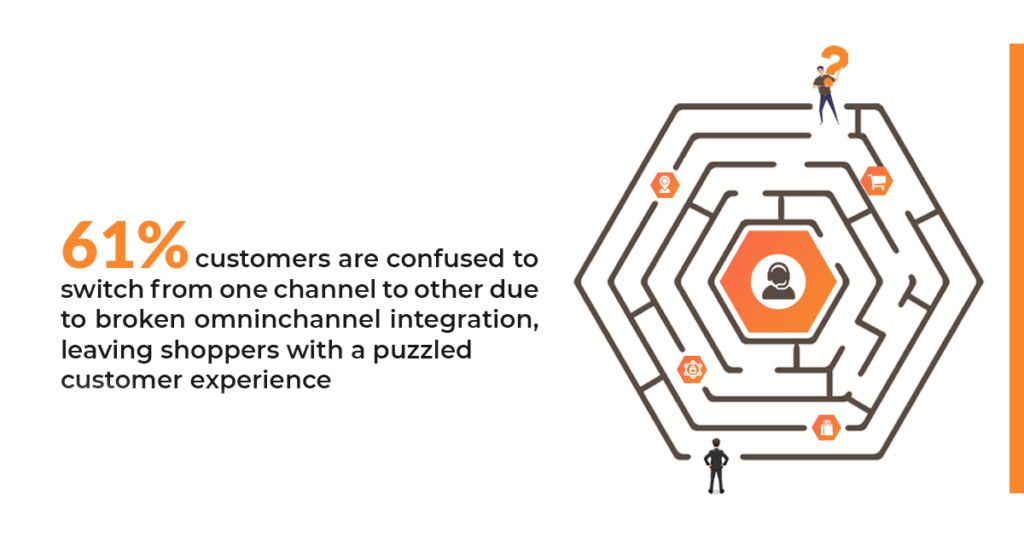
A recently conducted quantitative research to understand customer preferences and attitudes for customer service across various channels, including during the holiday season yielded exciting discoveries about customers’ attitudes about omnichannel customer service.
While most of the customers who responded have encountered trouble switching channels, the substantial majority (91%) believe that they should be capable of picking up where they last left off when reaching customer service about the similar issue. They also hate having to repeat themselves (89%).
The infographic given below shows a few other vital conclusions – and explains that when it comes to receiving the service they expect; most buyers are tired of playing around!
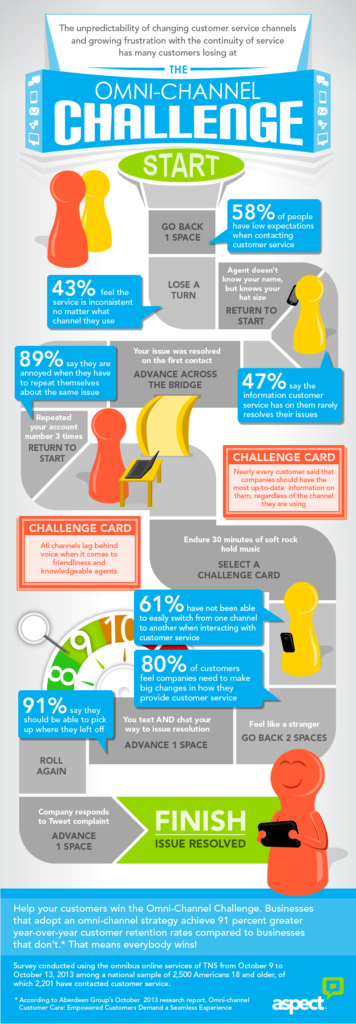
Source: Aspect
Also read: Strategies To Boost B2B ECommerce Business During COVID-19 Pandemic
5. 71% of shoppers who use their smartphones for research say their device has become more important to their in-store experience
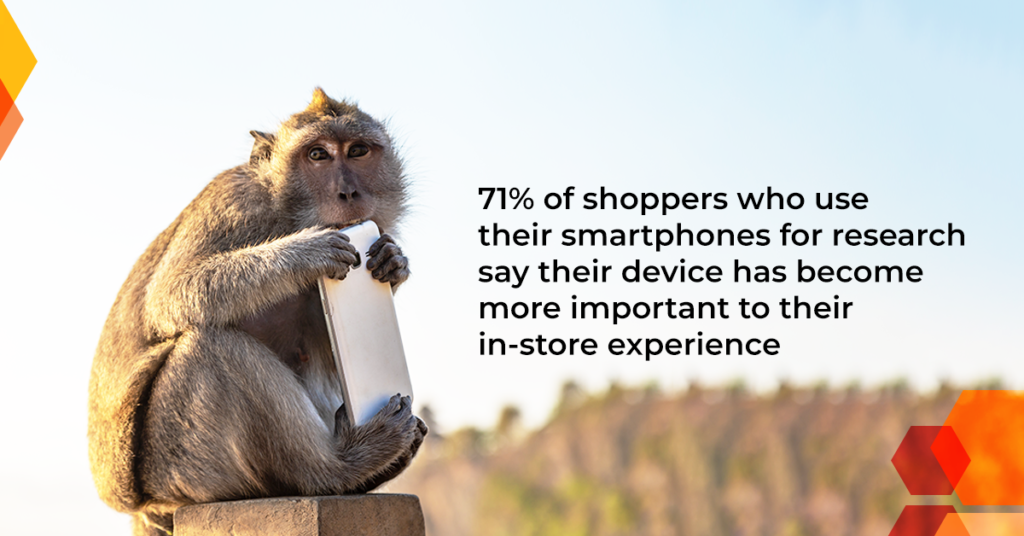
To better grasp the influence of smartphones and online knowledge on in-store shopping, Google partnered with Ipsos MediaCT and Sterling Brands for an online study. The research reveals that buyers want more learning and customized experiences during their shopping journey: Two in three customers who tried to gain information within a store say they didn’t find what they needed, and 43% left frustrated. And 71% of in-store customers who use smartphones for online research say their smartphone has become more valuable to their in-store experience.
Businesses can use these insights to connect and engage with shoppers, from providing consumers with local information online before they go to stores to customize their experiences once they’re in-store, various digital platforms presents new possibilities for retailers to connect with customers.
Also read: Key Customer Experience (CX) Strategies To Drive Conversions On Your ECommerce Website
6. 90% of customers expect consistent interactions across channels

According to a global study by SDL, 90% of customers said they expect their customer experience to be consistent across devices and channels used to interact with brands this holiday shopping season. The figure represents a 17% improvement from what customers reported last year.
The report finds that 47% of holiday customers have been disappointed that in-store impressions are different from online impressions, and 40% have reported a disconnect between the information available online versus in stores. Strengthening the need for consistency, the top two reasons shoppers say they are loyal to their favourite businesses are consistent, anticipated service and a consistent experience across all devices they use to interact with the brand.
“Consumers today engage with organizations through multiple touchpoints,” said Mark Lancaster, CEO and founder, SDL. “Today, more than ever, brands need to be prepared to cater to shoppers wherever they are as they research and purchase products–in-store, online or on their mobile devices. A consistent, superior experience across all interaction channels has become something that customers not only expect, but they demand it, and the brands that can best meet this demand will build customer relationships that continue long after the holiday season.”
Also read: How E-Commerce Is Flourishing Amidst The Coronavirus Outbreak
Conclusion-
Offering an omnichannel customer experience isn’t just an optional strategy anymore; it’s has become mandatory. Today’s customer is omnipresent, and brands need to start recognizing that.
Apexon’s omnichannel implementation experience ensures your customers get a delightful experience across the merchandising channels; be it web, mobile app development, tablets or any other. We provide an entire spectrum of services ranging from analysis, design, configuration, implementation, testing to post-production support and enhancements.
By building an omnichannel customer service strategy, you’ll be able to sustain a great connection with your customers and encourage more trust in your brand. Contact us to implement omnichannel customer experience for your business now!




